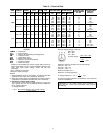
CONDENSATE DRAIN — Check and clean each year at
start of cooling season. In winter, keep drain dry or protect
against freeze-up.
FILTERS — Clean or replace at start of each heating and
cooling season, or more often if operating conditions require
it. Replacement filters must be same dimensions as original
filters.
OUTDOOR-AIR INLET SCREENS — Clean screens with
steam or hot water and a mild detergent. Do not use dis-
posable filters in place of screens.
Lubrication
COMPRESSORS — Each compressor is charged with cor-
rect amount of oil at the factory.
FAN-MOTOR BEARINGS — Fan motor bearings are of
the permanently-lubricated type. No further lubrication is
required. No lubrication of outdoor- or indoor-fan motors is
required.
Outdoor-Fan Adjustment (Fig. 24)
1. Shut off unit power supply.
2. Remove outdoor-fan assembly (grille, motor, motor cover
and fan) and loosen fan hub setscrews.
3. Adjust fan height as shown in Fig. 24.
4. Tighten setscrews and replace outdoor-fan assembly.
Refrigerant Charge — Amount of refrigerant charge
is listed on the unit nameplate (also refer to Tables 1A and
1B). Refer to Carrier Standard Service Techniques Manual,
Chapter 1, Refrigerants section.
Unit panels must be in place when unit is operating dur-
ing charging procedure.
LOW CHARGE HEATING OR NO CHARGE — Use stand-
ard evacuating techniques. After evacuating system, weigh
in the specified amount of refrigerant (refer to Tables 1Aand
1B).
LOW CHARGE COOLING — Use Cooling Charging Chart,
Fig. 25 and 26. Vary refrigerant until the conditions of the
chart are met. Note the charging chart is different from type
normally used. Chart is based on charging the units to the
correct superheat for the various operating conditions. Ac-
curate pressure gage and temperature sensing device are re-
quired. Connect the pressure gage to the service port on the
suction line. Mount the temperature sensing device on the
suction line and insulate is so that outdoor ambient tempera-
ture does not affect the reading. Indoor-air L/s (cfm) must be
within the normal operating range of the unit.
TO USE COOLING CHARGING CHART — Take the out-
door ambient temperature and read the suction pressure gage.
Refer to chart to determine what suction temperature should
be. If suction temperature is high, add refrigerant. If suction
temperature is low, carefully blow some of the charge. Re-
check the suction pressure as charge is adjusted.
Example: (Fig. 26) (Circuit 1)
Outdoor Temperature ....................29C(85F)
Suction Pressure ...................483kPa(70psig)
Suction Temperature should be .............7C(46F)
(Suction Temperature may vary ± 3° C (5° F)
If Chargemaster charging device is used, temperature and
pressure readings must be accomplished using the charging
chart.
Fig.24 — Outdoor-Fan Adjustment
20


















